We know, we know — everyone loves the barbell bench press. That’s why it’s so hard to find an available bench press station most of the time (nevermind on Mondays, or as gym bros all over the world call it, “International Chest Day”).
Here’s the thing, though: The dumbbell bench press is just as good for most people, most of the time and, occasionally, even better. That’s why we put this guide to dumbbell bench press form together, because you should learn to love this chest-building staple as much as we do, no matter your goals. Let’s get started.
Recent Updates: BarBend Senior Writer Jake Dickson updated this article to make the content more accessible and provide more contemporary guidance that aligns with BarBend‘s evolving standards for exercise prescription. Read more about that process here.
Dumbbell Bench Press Video Guide
Check out our video guide for even more information on how to execute the flat dumbbell bench press flawlessly.
How To Do the Dumbbell Bench Press
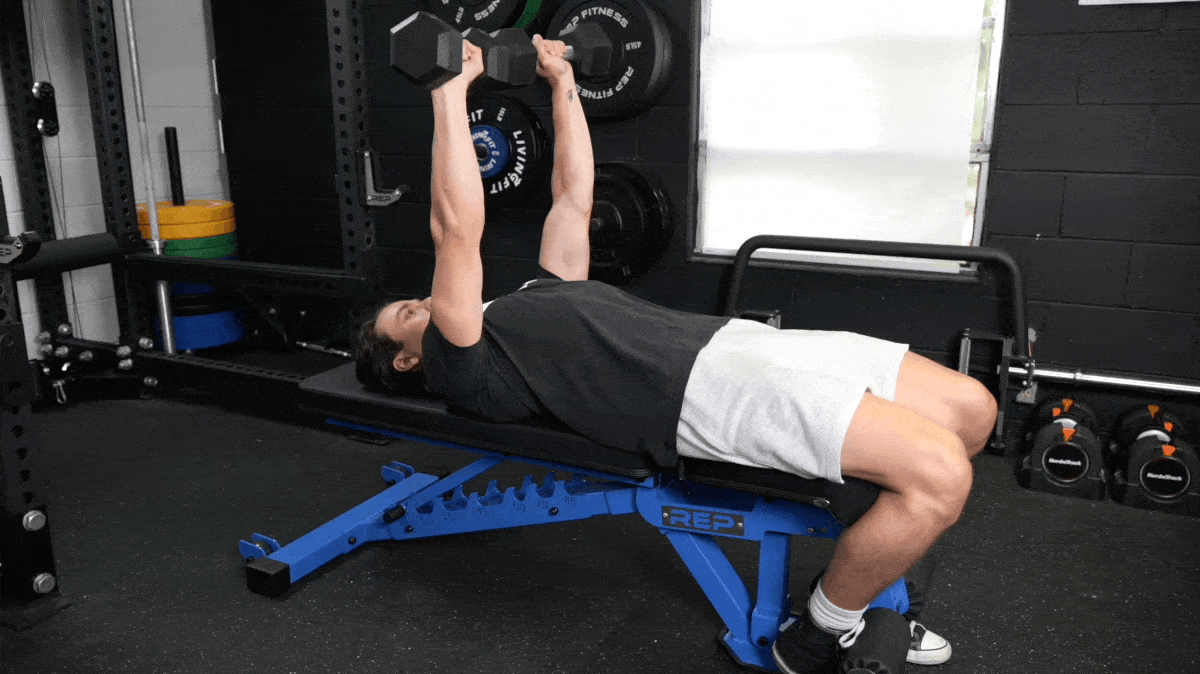
[Read More: Incline Bench Press vs. Flat Bench Press]
- Step 1 — Grip each dumbbell firmly, and then squeeze your shoulder blades together. Kick one knee up to drive a dumbbell to your shoulder. Then, drive the other knee up. (Be careful not to launch the dumbbells too hard and risk hitting your head.) As you drive the last dumbbell up, lay back down on the bench.
- Step 2 — Squeeze your shoulder blades together and ensure your feet are actively pressing into the floor.
- Step 3 — Slowly lower the dumbbells down toward your chest. The weights should fall both down and out to the sides. Lower until your upper arm is parallel (or lower) to the floor, then press back up.
Coach’s Tip: One of the best bench press cues is to think about pressing the weights both up and inward during this exercise, like you’re tracing a triangle.
Sets and Reps
- For Beginners: 3 x 10
- To Build Muscle: 4 x 6-8
Modifications
- Make It Easier: Try lying on the floor and performing this move with light dumbbells.
- Make It Harder: Pick your feet up and place them on the end of the bench to reduce your stability, or elevate the bench seat and perform the incline dumbbell bench press.
Dumbbell Bench Press Variations
There are a few more modifications you can make to the dumbbell chest press. If you’re looking for bench press variations, give these a shot:
- Dumbbell Floor Press: By laying on the floor, you restrict the overall range of motion in the pressing movement, increasing the demands on the triceps to assist in the lockout position. Additionally, it can help you establish a deeper understanding of how to stabilize your upper back.
- Dumbbell Hex Press: The hex press changes the angle of your upper arm, which affects chest activation. Hex presses are a type of close-grip dumbbell bench press and also are a bit easier on the shoulders for most folks.
“Single-arm bench presses or alternating bench presses can help to improve muscle balance, symmetry and coordination,” Furr offers.
“By incorporating single-arm dumbbell bench press variations into your chest workout routine you add variety and can challenge your muscles in a different way.”
Dumbbell Bench Press Alternatives
If the dumbbell bench just isn’t right for you, don’t fret. Below are a few dumbbell bench press alternatives you can use instead to work similar muscles:
Dumbbell Overhead Press
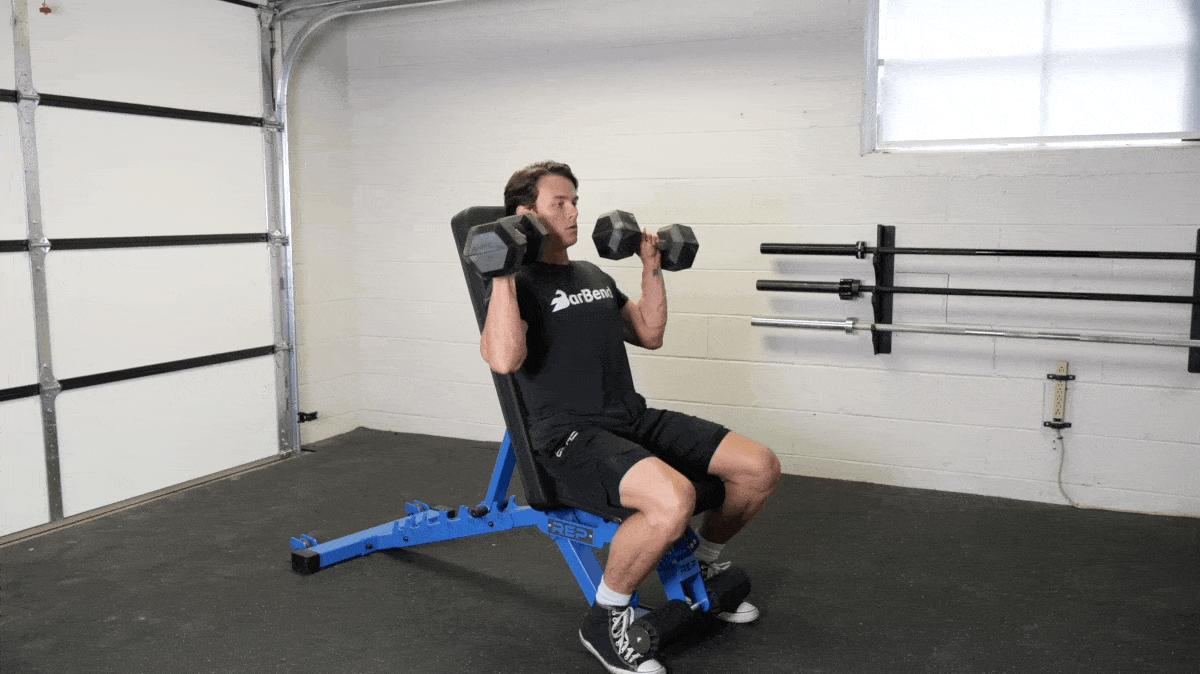
[Read More: The Best Bench Press Workouts for Your Experience Level]
- Take an adjustable weight bench seat and fix it to roughly 90 degrees.
- Sit with a dumbbell on each knee.
- Kick the weights up to shoulder height, then take a breath in and brace your core.
- Press the weights up overhead until your arms fully extend.
Barbell Bench Press
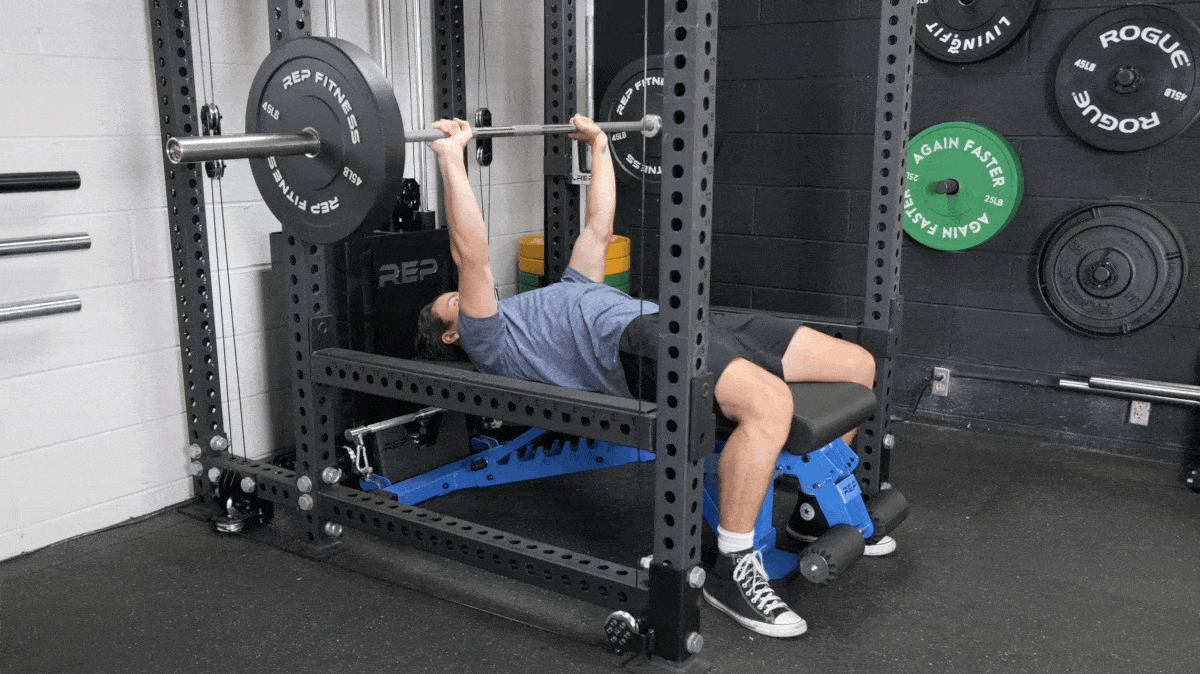
[Read More: Dumbbell Vs. Barbell Bench Press — Which is Best for Strength, Size, and Performance?]
- Lie under a barbell that has been set into a squat rack or bench station.
- Unrack the bar and hold it with a shoulder-width grip directly above your shoulders.
- Inhale, brace your core, and lower the weight down until it touches around your sternum or nipple line, keeping your elbows under the bar the whole way.
- Press the bar up and back until it returns to its starting position over your shoulders.
Dumbbell Hip Extension Floor Press
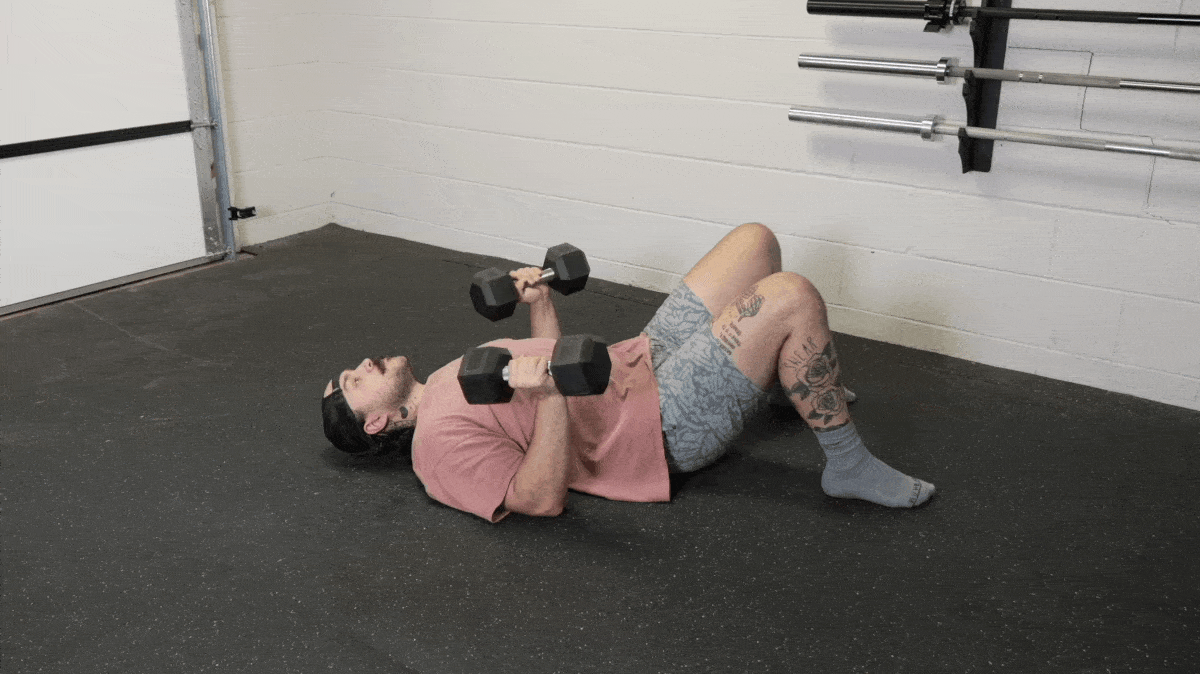
[Read More: The Incline Dumbbell Bench Press Will Unlock Your Muscle-Building Potential]
- Lie on the floor while holding a pair of dumbbells at arm’s length.
- Contract your glutes to lift your hips off the floor and hold them in an extended position.
- Lower the weights down until your elbows touch the floor, then press back up.
Muscles Worked by the Dumbbell Bench Press
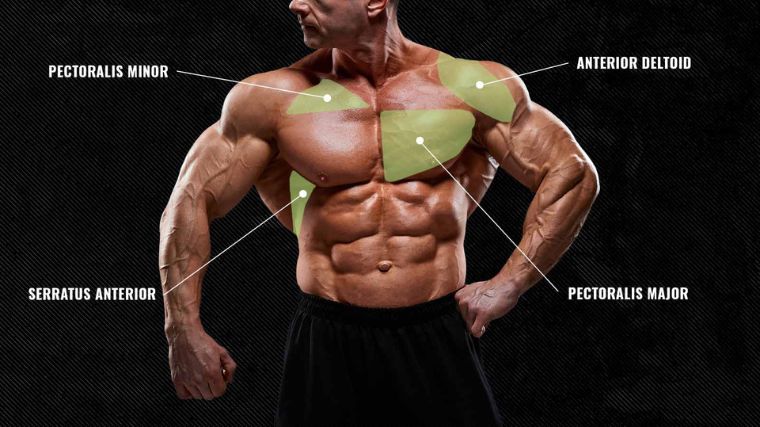
The dumbbell bench press is an extremely effective movement for increasing upper body strength and muscle mass for both aesthetics and performance. Below are the critical muscles stressed during the dumbbell bench press.
- Pectoralis Major: The pectoral muscles are the primary muscle groups involved in the force production needed to perform the dumbbell bench press. Your pecs primarily work during the bottom half of the range of motion.
- Anterior Deltoid: The deltoids are what move the ball-and-socket shoulder joint so your arms can reach in all directions. While your triceps and chest are doing most of the work, the shoulders are working to stabilize the shoulder joint and assist with the press.
- Triceps Brachii: The triceps are involved in the stability of the elbow and responsible for the final extension of the elbow to lock out the bench press. You can tweak your bench press grip width and style to better isolate your triceps by performing movements like the close-grip bench press.
Benefits of the Dumbbell Bench Press
While the bench press is often seen as a “bro-sesh” kind of movement, it can truly develop the upper body strength and muscle mass needed no matter what your goals are in the gym. Here are a few benefits of doing the dumbbell bench press.
“Dumbbell exercises often mimic natural movement patterns more closely than barbell exercises. This can translate to improved functional strength that can benefit daily activities and sports performance,” Furr explains.
More Muscle and Strength
Bench pressing in general can create some serious strength and muscle hypertrophy gains. No matter the sport, nearly every lifter could benefit from increased strength and more muscle mass. The bench press, as well as overhead movements, are critical for upper body pushing strength development.
Freedom of Movement
Compared to barbells, which force your joints into a fixed position, dumbbells grant a lifter the ability to adjust their grip. Some lifters may experience pain if their elbows are rotated at a certain angle (which is dictated by hand position).
During the standard barbell bench press, flared-out elbows can also put the onus on the shoulder joint. A more joint-friendly option is to do the dumbbell bench press with a neutral grip. This will create a more natural and comfortable joint angle from the wrist to the shoulder joint. You can’t do this with a barbell.
Increased Unilateral Strength
Everyone has a stronger side. People naturally lean more to one side and use one arm more than the other. When performing barbell movements, it’s normal for one side of the body to work harder to lift the combined weight. However, using dumbbells allow each side of the body to work independently.
[Related: Read Up on These 9 Proven Benefits of the Bench Press]
This will give your left or right chest, shoulder, and triceps muscles a chance to play catch up. Also, that now-stronger side will help you lift more weight on barbell movements.
Longer Range of Motion
Because there’s no barbell tapping your chest, you can lower the dumbbells farther than a barbell bench press. This means that you’ll stretch your muscle fibers more (which means more muscular damage and, therefore, growth) and take your shoulder joints through a more extended range of motion.
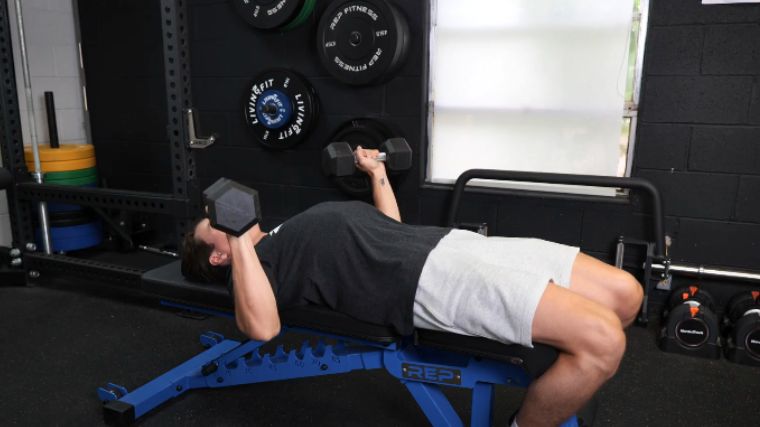
[Read More: How to Increase Your Bench Press — Tips and Programs to Try]
Your joints want to move, so increasing the shoulder joints’ range of motion will mean you have stronger, more resilient shoulders over time.
Common Dumbbell Bench Press Mistakes
It may not be as intricate as the snatch, or even a powerlifter’s bench press, but things can still go sideways with dumbbell work. Here are a couple of common bench press mistakes to avoid when learning how to do the dumbbell bench press.
Starting Too Heavy
Since you’re working with two separate implements at once, dumbbell exercises come with a larger stability demand. If you start off trying to match your barbell bench press weight (two 90-pound dumbbells if you bench 180 pounds, for instance) you might be surprised at how hard it is to control.
Leave your ego at the door and start extra-conservatively if you’re new to dumbbell training.
Alternating Your Arms
Unless you’re prioritizing muscular endurance, there’s no real reason to press with one arm at a time. This will essentially double the amount of time the set takes, but holding a dumbbell aloft at arm’s length does little for muscle growth or absolute strength.
It might be a fun way to switch things up once in a while, but for most fitness goals, pressing the weights simultaneously works just fine. Keep it simple.
Pressing Too Shallow
Tactically cutting out a portion of your range of motion can be great for strength gains, but if you’re learning to dumbbell bench press for the first time, there’s no reason to stop short. As long as your mobility and comfort permit, you should lower the weights until they’re roughly around chest level.
Wrapping Up
Whether you want to build muscle, increase strength, or just develop more overall upper-body fitness, the dumbbell bench press should be one of your go-to movements. We adore it for its simplicity and accessibility, but you can certainly find your own reason to love the movement. All you have to do is dive in.
FAQs
If you’ve still got some nagging questions about dumbbell work, look no further. Here are a few common concerns laid to rest.
The depth at which you lower the weights can vary based on goal (attacking sticking points versus maximizing muscular development), shoulder structure, and previous injuries/discomforts. For most individuals, I would suggest lowering the loads so that the sides of the weights touch the sides of the chest. This will often be a deeper range of motion, which will increase muscle development. If pain exists in that full range of motion, drop the load and see if the pain goes away. If it doesn’t stop what you’re doing.
If you are finding the movement causes shoulder pain and discomfort, first you need to review your dumbbell bench press form and technique. If this is still occurring, make sure you are maintaining back tension in both the eccentric and concentric phase of the movement. If you still have pain and discomfort, you can tuck the elbows more into the body to make the dumbbell bench press more of a neutral grip bench press. If you still have pain, lower the load. And lastly, if you still have pain, stop doing the dumbbell bench press and consult a medical professional for clear insight on potential injury.
This is all dependent on the goal, which you can review in the above sections. If you are using the dumbbell bench press to support muscle growth and strength specific to the barbell bench press, try using heavy loads that allow you to train in the strength and/or hypertrophy ranges listed above. If you are looking to develop overall strength for the upper body, you can diversify your workout intensity to include all rep ranges listed above.